Xeriscape Landscape Plants & Flowers
For The Arizona Desert Environment.
Pictures, Photos, Images, Descriptions, & Reviews.
Mescal Ceniza Agave, Agave colorata.
We Are Proud Of Our SafeSurf Rating!
Click On Any Of The Following Links By Amazon.Com
For Books, & Videos About Wildflowers Of Arizona & The Southwest USA. No Obligation!
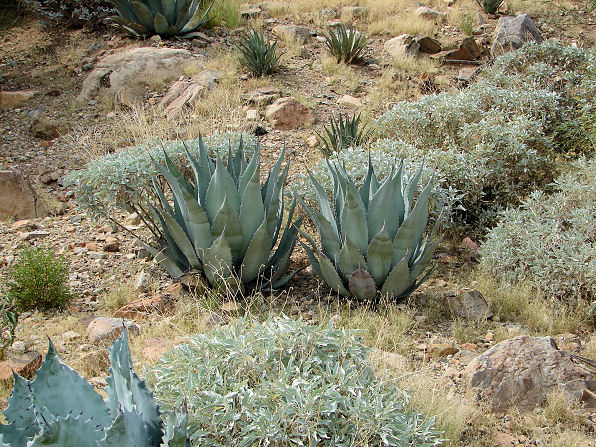 |
| Mescal Ceniza Agave, Agave colorata. Arizona - Sonora Desert Museum. Near Tucson, Arizona. September 29, 2006. |
|---|
 |
| Mescal Ceniza Agave, Agave colorata. Arizona - Sonora Desert Museum. Near Tucson, Arizona. September 29, 2006. One Is Dying After Blooming. One Is In Bloom. |
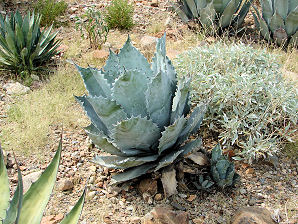 | 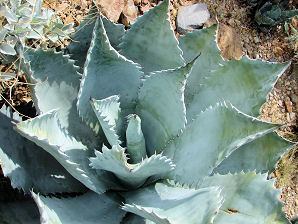 |
| Mescal Ceniza Agave. Agave colorata. | Mescal Ceniza Agave. Agave colorata. |
|---|---|
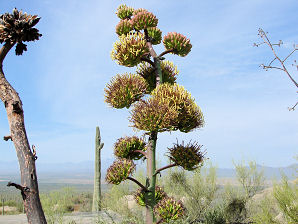 | 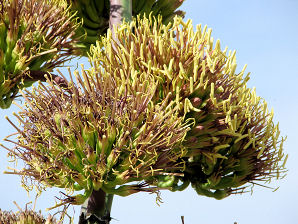 |
| Mescal Ceniza Agave. Agave colorata. | Mescal Ceniza Agave. Agave colorata. |
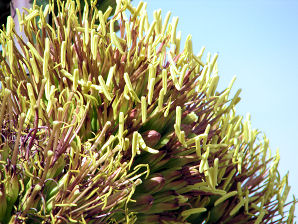 | 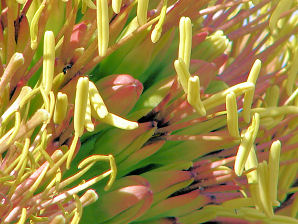 |
| Mescal Ceniza Agave. Agave colorata. | Mescal Ceniza Agave. Agave colorata. |
 /
/

Mescal Ceniza Agave.
We wish to thank Wikipedia, the free encyclopedia for some of the information on this page. We share images and information with Wikipedia. A beautiful, small to medium Agave from Sonora and northern Sinaloa in Mexico which has very wide, heavily cross-banded, blue and purplish leaves. It is highly tolerant of drought conditions and full sun. It forms a succulent rosette, slowly clumping, 2 to 4 feet in diameter. Mature plants develop a short stem about 4 - 6 feet tall. Plants in nature have bands running across the leaves, created by the alternation of zones with a blue - gray coating and darker zones. However, this banding is seldom encountered on plants in cultivation.
This is one of the most ornamental of the agaves coming to us from the Chihuahua and Sonora Desert in Mexico. The dark green leaf color and the decorative teeth make this plant very attractive. The ornamental nature of this plant makes it an ideal plant for entryways.
Quick Notes:
Height: 2 to 4 feet feet tall. It also spreads about 2 to 4 feet.
Flowers: A short stalk emerges from the center of the plant, it becomes 6 to 10 feet tall. Then yellow to orange flowers emerge from the stalk on 20 - 30 short side branches. Then bright yellow - green flowers about 2 inches long form. The flower stalk signals the end of the plant's life cycle..
Flowering Time: Phoenix Arizona, Mid March - April.
Leaves: The leaves form a basal rosette, they grow up to 2 1/2 feet long, and nearly 8 inches wide, dark green, lance-shaped; wider in the middle, and tapering to the tip, with dark brown, decorative teeth. They curve both, away from, and back, towards the center of the plant.
Found: Native of coastal northwestern Mexico (Sonora, and northern Sinaloa).
Hardiness:
Soil pH requirements:
Sun Exposure:
Elevation: 0 - 6,000 feet. In Arizona.
Habitat: Native in sand, sandy loam, clay and other heavy soils. It needs good drainage and aeration. It is remarkably tolerant of alkali. Hardy to 15� F.
Miscellaneous: Maintenance: Low. Photos Taken; Arizona - Sonora Desert Museum near Tucson, Arizona. September 29, 2006. Again Blooming On April 19, 2008.
|



We Are Proud Of Our SafeSurf Rating!
Click On Any Of The Following Links By Amazon.Com
For Books, & Videos About Xerioscape Plants Of Arizona & The Southwest USA. No Obligation!
Back To Arizona Xeriscape Landscaping Main Page.
Back To Xeriscape Succulents Page Three.
Back To Arizona Wild Flowers Home Page.
Back To DeLange Home Page
© 1966 - Present, Audrey, Eve, & George DeLange
| © 1966 - Present, Audrey, Eve, & George DeLange |


